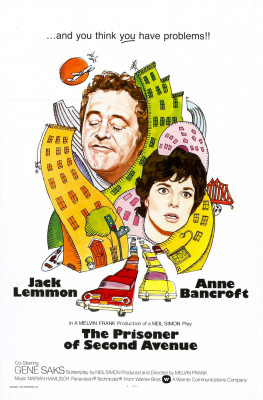| Reviews & Columns |
|
Reviews DVD TV on DVD Blu-ray 4K UHD International DVDs In Theaters Reviews by Studio Video Games Features Collector Series DVDs Easter Egg Database Interviews DVD Talk Radio Feature Articles Columns Anime Talk DVD Savant Horror DVDs The M.O.D. Squad Art House HD Talk Silent DVD
|
DVD Talk Forum |
|
|
| Resources |
|
DVD Price Search Customer Service #'s RCE Info Links |
|
Columns
|
|
|
Prisoner of Second Avenue, The
In Manhattan's Upper East Side, Edna and Mel, along with the rest of New York, suffer through a stifling heat wave causing power outages and problems with the city's water supply. He works in an office not unlike that in Billy Wilder's The Apartment, only it's now in the middle of an economic recession, and instead of hundreds of busy-bee workers his company is downsizing daily and the floor he works on is bereft of employees and activity. Early in the story he, too, is sacked.
Edna has problems of her own. Returning from a brief run to the store she finds their apartment ransacked, burglars having stolen their color TV, their booze, all of Mel's suits - anything of value. Mel, at 48 years ago, struggles to find a new job, and with rent due Edna finds full-time work returning to her old job as a script girl for a television production company. Mel, stuck at home, becomes increasingly depressed, alternately bitter and zombie-like, so Edna turns to Harry (Gene Saks), Mel's father figure-like older brother, for help.
The original play opened on Broadway in November 1971, directed by Mike Nichols and starring Peter Falk as Mel and Lee Grant as Edna. Without ever seeing it, it's easy to imagine how that version might have differed from the film, which Simon himself adapted. Lemmon in the early scenes is almost clinically unnerving as a man coming apart at the seams, to whom the entire planet seems to be conspiring against. Everything bothers him, from the terrible anxiety of imminently losing his job of 24 years to the smell of garbage wafting up from the sidewalk 14 floors below. At night every little noise drives him to obsessive distraction: a barking dog, stewardesses playing music next-door, and so on. Lemmon's great in these scenes, while Anne Bancroft's reactions, trying to make sense of her husband's increasingly irrational behavior, are priceless.
After Mel's breakdown, however, Lemmon falls back on the same kind of mannered, glazed-over self-pity as his Felix Unger in the film version of The Odd Couple (directed by Gene Saks, 1968). Peter Falk, one imagines, probably played those scenes with more unpredictable volitivity, the Broadway audience never sure just how unhinged Falk would become. As written, both approaches are possible, but Lemmon's doesn't really work.
Another problem with the film is its now very dated attitudes about the roles of husbands and wives. Much of the dramatic conflict in the middle of the story revolves around Mel's resentment and self-loathing that, however temporarily, he and Edna have reversed roles: she's the breadwinner and he's the homemaker, though he doesn't do much beyond loafing around unshaven in his bathrobe. The terrible shame felt by a man that his wife has to work seems almost quaint today, in an economy in which both spouses almost always work, even when they have children. Mel's bitter, traditionalist views come off as chauvinistic.
The strained relationship between Mel and his older brother also doesn't come off in the film version. Just as The Sunshine Boys doesn't really work with two gentiles in the leading parts, in The Prisoner of Second Avenue the Jewish New York-type dialogue between the two siblings comes off weird when the brothers are Irish-Catholic Lemmon and Jewish actor-director Saks. Melvin Frank's direction wavers between realism and more typical ‘70s Neil Simon-style comedy.
Nevertheless, Simon's dialogues of the bickering, unhappy couple have their fair share of laughs, mostly in Edna's reactions to her husband's strange, erratic behavior. Filmed in New York with interiors shot at Warner Bros. in Burbank, the cast is composed of top stage talent, including M. Emmet Walsh and F. Murray Abraham in small roles. Sylvester Stallone has a memorable bit as well, filmed just prior to Rocky.
Video & Audio
Warner Archive's new Blu-ray of The Prisoner of Second Avenue, filmed in Panavision, looks great. The image is impressively sharp throughout with accurate color, and has no obvious signs of wear or damage. The DTS-HD Master Audio (2.0 mono) is also well above average, and optional English subtitles are included.
Extra Features
The limited supplements, apparently repurposed from an earlier DVD edition, include a pleasant excerpt from Dinah!, the Dinah Shore-hosted afternoon talk show, with Bancroft and the host chatting about Mel (Brooks, Bancroft's husband) and Burt (Reynolds, Shore's boy-toy of the period) and includes brief film clips. The archival featurette The Making of The Prisoner of Second Avenue is above average for these things, with on-location footage and interviews with the stars, including the shooting of Stallone's big scene. An okay trailer rounds out the extras.
Parting Thoughts
Fair-to-middling at best, The Prisoner of Second Avenue is dated and at times labored, but not without interest. Some of it is very well done, other aspects don't work. For Neil Simon admirers or fans of its stars, it's Recommended.
Stuart Galbraith IV is the Kyoto-based film historian currently restoring a 200-year-old Japanese farmhouse.
|
| Popular Reviews |
| Sponsored Links |
|
|
| Sponsored Links |
|
|
| Release List | Reviews | Shop | Newsletter | Forum | DVD Giveaways | Blu-Ray | Advertise |
|
Copyright 2024 DVDTalk.com All Rights Reserved. Legal Info, Privacy Policy, Terms of Use,
Manage Preferences,
Your Privacy Choices | |||||||















